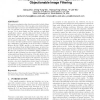Free Online Productivity Tools
i2Speak
i2Symbol
i2OCR
iTex2Img
iWeb2Print
iWeb2Shot
i2Type
iPdf2Split
iPdf2Merge
i2Bopomofo
i2Arabic
i2Style
i2Image
i2PDF
iLatex2Rtf
Sci2ools
125
Voted
MM
2004
ACM
2004
ACM
An adaptive skin model and its application to objectionable image filtering
We propose an adaptive skin-detection method, which allows modelling and detection of the true skin-color pixels with significantly higher accuracy and flexibility than previous methods. In principle, the proposed approach follows a two-step process. For a given image, we first perform a rough skin classification using a generic skin-model which defines the Skin-Similar space. The Skin-Similar space often contains many non-skin pixels due to the inevitable overlap in the color space between skin pixels and some non-skin pixels under the generic skin-model. The objective of the second step is to reduce the false-positive rate by analyzing the image under consideration. Specifically, in the second step, a Gaussian Mixture Model (GMM), specific to the image under consideration and refined from its Skin-Similar space, is derived using the standard Expectation-Maximization (EM) algorithm. We then use a Support Vector Machine (SVM) classifier to identify the skin Gaussian from the ...
Related Content
| Added | 30 Jun 2010 |
| Updated | 30 Jun 2010 |
| Type | Conference |
| Year | 2004 |
| Where | MM |
| Authors | Qiang Zhu, Ching-Tung Wu, Kwang-Ting Cheng, Yi-Leh Wu |
Comments (0)

